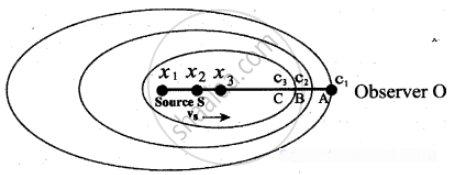Advertisements
Advertisements
Question
Discuss the following case:
Source in motion and Observer at rest
- Source moves towards observer
- Source moves away from the observer
Solution
(a) Source moves towards die observer-

Source S moves towards an observer O (right) with velocity
Suppose a source S moves to the right (as shown in Figure) with a velocity vs and let the frequency of the sound waves produced by the source be fs. It is assumed that the velocity of sound in a medium is v.
Suppose a source S moves to the right (as shown in Figure) with a velocity vs and let the frequency of the sound waves produced by the source be fs. It is assumed that the velocity of sound in a medium is v.
The compression (sound wavefront) produced by the source S at three successive instants of time are shown in the Figure. When S is at position x1 the compression is at C1. When S is at position x2, the compression is at C2 and similarly for x3 and C3.
It is meant that the wavelength decreases when the source S moves towards the observer O. But frequency is inversely related to wavelength and therefore, frequency increases.
Calculation:
Let λ be the wavelength of the source S as measured by the observer when S is at position x1 and λ’ be the wavelength of the source observed by the observer when S moves to position x2.
Then the change in wavelength is ∆λ = λ – λ’ = vst, where t is the time taken by the source to travel between x1 and x2 Therefore,
λ’ = λ – vst … (1)
But t = \[\frac{λ}{v}\] … (2)
On substituting equations (2) in equation (1), we get.
`lambda' = lambda(1 - "v"_"s"/"v")`
Since frequency is inversely proportional to wavelength, we have
`"f"' = "v"_"s"/(lambda')` and f = `"v"_"s"/lambda`
Hence `"f"' = "f"/((1 - "v"_"s"/"v"))` ...(3)
Since, `"v"_"s"/"v"` << 1, by using the binomial expansion and retaining only first order in `"v"_"s"/"v"`, we get
`"f"' = "f"(1 + "v"_"s"/"v")` ...(4)
(b) Source moves away from the observer-
Since the velocity of the source is opposite in direction when compared to case (a), hence by changing the sign of the velocity of the source in the above case i.e., by substituting (vs → – v ) in equation (1), we get
`"f"' = "f"/((1 + "v"_"s"/"v"))` ....(5)
Using binomial expansion again, we get
`"f"' = "f"(1 - "v"_"s"/"v")` .....(6)
APPEARS IN
RELATED QUESTIONS
The engine of a train sounds a whistle at frequency v. The frequency heard by a passenger is
Solve the following problem.
A police car travels towards a stationary observer at a speed of 15 m/s. The siren on the car emits a sound of frequency 250 Hz. Calculate the recorded frequency. The speed of sound is 340 m/s.
The sound emitted from the siren of an ambulance has a frequency of 1500 Hz. The speed of sound is 340 m/s. Calculate the difference in frequencies heard by a stationary observer if the ambulance initially travels towards and then away from the observer at a speed of 30 m/s.
Explain red shift and blue shift in Doppler Effect.
Two cars moving in opposite directions approach each other with speed of 22 m/s and 16.5 m/s respectively. The driver of the first car blows a horn having a frequency 400 Hz. The frequency heard by the driver of the second car is [velocity of sound 340 m/s]: ____________.
If a star appearing yellow starts accelerating towards the earth, its colour appears to be turned ______.
A source of sound is moving towards a stationary observer with velocity 'Vs' and then moves away with velocity 'Vs'. Assume that the medium through which the sound waves travel is at rest, if 'V' is the velocity of sound and 'n' is the frequency emitted by the source, then the difference between the apparent frequencies heard by the observer is ______.
The difference between the apparent frequency of a stationary source of sound as perceived by the observer during its approach and recession is 2% of the frequency of the source. If the speed of sound in air is 300 ms–1, then the velocity of the observer is
The frequency of a car horn encountered a change from 400 Hz to 500 Hz, when the car approaches a vertical wall. If the speed of sound is 330 m/s. Then the speed of car is ______ km/h.
The period of rotation of the sun at its equator is T and its radius is R. Then the Doppler wavelength shift expected for light with wavelength λ emitted from the edge of the sun's disc is: [c = speed of light]
